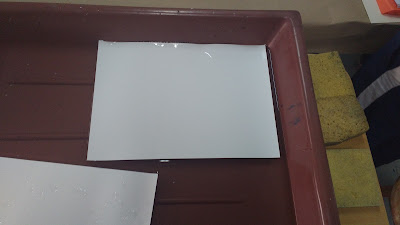Art
First, I painted the parts of my product that had to be white and gray.
María Paula Daza (Colombia 2002)
"Process of creation, Image #1"
Image taken in Art class.
March 2, 2017.
María Paula Daza (Colombia 2002)
"Process of creation, Image #2"
Image taken in Art class.
March 2, 2017.
Then, I let the plate burn during 55 seconds.
María Paula Daza (Colombia 2002)
"Process of creation, Image #3"
Image taken in Art class.
March 2, 2017.
Next, I left the carboard wetting.
María Paula Daza (Colombia 2002)
"Process of creation, Image #4"
Image taken in Art class.
March 2, 2017.
Later, I dry it with the help of a sponge.
María Paula Daza (Colombia 2002)
"Process of creation, Image #5"
Image taken in Art class.
March 2, 2017.
Also, I spread ink in my plate with the help of gloves and some newspaper.
Finally, I print it.
María Paula Daza (Colombia 2002)
"Process of creation, Image #6"
Image taken in Art class.
March 2, 2017.
Due to some mistakes in the process of creation, I had to repeat the process in order to accomplish my objectives.
First, I paint the parts I wanted to be in white and gray colors.
María Paula Daza (Colombia 2002)
"Process of creation, Image #1"
Image taken in Art class.
March 6, 2017.
I let my plate burning for about 7 minutes.
María Paula Daza (Colombia 2002)
"Process of creation, Image #2"
Image taken in Art class.
March 6, 2017.
Then, I washed my plate.
María Paula Daza (Colombia 2002)
"Process of creation, Image #2"
Image taken in Art class.
March 6, 2017.
Also, I spread ink in my plate with the help of gloves and some newspaper.
Finally, I printed in two carboards to see better results. I liked more one of them, the one I did first.
María Paula Daza (Colombia 2002)
"Process of creation, Image #3"
Image taken in Art class.
March 6, 2017.
This is how my plate looks like:
María Paula Daza (Colombia 2002)
"Process of creation, Image #1"
Image taken in Art class.
March 7, 2017.
The following image shows my second printing:
María Paula Daza (Colombia 2002)
"Process of creation, Image #2"
Image taken in Art class.
March 7, 2017.
The following image shows my third and final printing:
María Paula Daza (Colombia 2002)
"Process of creation, Image #3"
Image taken in Art class.
March 7, 2017.
























